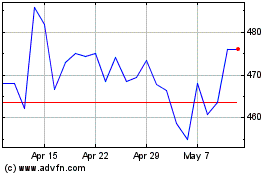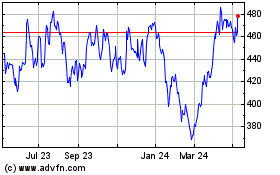The troubles of commodities giant Glencore PLC are benefiting
global markets as the company shuts down its supply of many
actively traded commodities from zinc to copper, sparking rallies
in these resources.
The gains, however, are often short lived, with investors soon
returning to the view that most commodity markets are oversupplied
at a time when demand is falling. For Glencore's actions to have a
lasting effect, other miners must follow. But many analysts believe
that this won't happen in a way big enough to push prices higher in
an era when China, the world's biggest consumer of most mined
commodities, is slowing down.
"Glencore's announcement will not be sufficient to engineer a
major turnaround in sentiment towards base metals or indeed mining
firms," said Sebastien Marlier, a commodities analyst at the
Economist Intelligence Unit.
Glencore said Friday it will cut annual zinc production by
roughly a third, or 500,000 metric tons, including closing two
mines. That is the equivalent of roughly 4% of the market in a
metal primarily used in steel production. The changes will also
reduce its annual output of lead, which is produced at those mines,
by about 100,000 tons.
The news sent the price of zinc up by 11.4% to a two-month high
of $1,857.50. Lead climbed 7% to a three-month high, before
settling up 5.4% at $1,763. The news boosted other industrial
metals, all of which traded higher throughout Friday.
The mine closures are the latest in a string of cuts from
Glencore, including coal, copper, platinum and cobalt, as sliding
commodity prices make it harder for the company to turn a profit
and reduce its $30 billion debt burden. The announcement comes at a
time when Glencore has been under scrutiny by investors, concerned
that falling raw-material prices could strain the mining and
commodity-trading group's finances.
The company's share price closed up 7% at 129.10 pence.
Some market participants see these cuts as a marker in an
important shift in sentiment among major producers and a signal
that the market was waking up to the high levels of oversupply
faced by many commodity markets. According to Macquarie, five of
the six major metals will have a surplus this year. Aluminum
producers will oversupply their market by 2.8%, the most of all
metals.
Most analysts argue that more cuts need to follow to make a
fundamental difference in prices.
Last month, Glencore said that it will shut down two
money-losing copper mines in Africa for 18 months, taking more than
1% of global output off markets. That sent copper prices spiking by
around 4%, but the metal soon sank and is now trading at around the
same levels it was before Glencore's announcement.
There have been cuts by smaller miners in commodities such as
coal and copper. But Freeport-McMoRan Inc. has been one of the few
other big miners to reduce output, announcing in August that it was
cutting about 68,000 tons from its annual copper production over
the next two years.
Many of the major miners, like Rio Tinto PLC and BHP Billiton
Ltd., have so far resisted joining the cuts, including in the coal
market that Glencore is active in and which has seen significant
price declines.
"[The] Glencore cuts tell you where it was losing money," said
Hunter Hillcoat, a commodities analyst at Investec. "While the coal
prices impact BHP and Rio as well, their assets are generally
higher quality, and therefore they've no need to cut
production."
In other words, some of these larger miners are unlikely to
cutback because they can often still make money. Giants like BHP
and Rio also have held back to see if the pressure of low prices
would force smaller, higher-cost mining outfits out of business,
analysts said.
Now analysts are scouring Glencore's portfolio to see what else
can be cut.
In commodities markets as a whole, nickel is seen as one of the
metals that miners need to tighten the most. Only 25% of production
in this metal, which is used in the production of stainless steel,
is profitable, said Ben Davis, analyst at Liberum Capital.
Underscoring the difficulties of balancing global supply and
demand, a cut to aluminum production by its biggest miners could
only encourage Chinese suppliers to plug the gap as they continue
to expand capacity.
For all commodities, whether supply is cut or not, China will
have a say on the end price, given its outsize role in demand.
China accounts for nearly half of total global zinc consumption,
45% of global copper consumption and 40% of lead production. Fears
about China's slowing economy in recent months have been a major
factor in the recent commodity price weakness. After years of
double-digit expansion and despite a series of economic
interventions by the government, the country is struggling to
maintain a 7% economic growth rate.
"If demand does not increase, then it would be tough for…prices
to sustain the momentum," said Daniel Ang, an analyst at Phillip
Futures.
Rhiannon Hoyle contributed to this article.
Write to Ese Erheriene at ese.erheriene@wsj.com and Alex
MacDonald at alex.macdonald@wsj.com
Subscribe to WSJ: http://online.wsj.com?mod=djnwires
(END) Dow Jones Newswires
October 09, 2015 13:55 ET (17:55 GMT)
Copyright (c) 2015 Dow Jones & Company, Inc.
Glencore (LSE:GLEN)
Historical Stock Chart
From Mar 2024 to Apr 2024

Glencore (LSE:GLEN)
Historical Stock Chart
From Apr 2023 to Apr 2024
